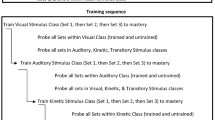Abstract
The purpose of the study was to use multiple exemplar training to teach empathetic responding to two children with autism. Three emotions—happiness, frustration and sadness/pain—were chosen for this purpose. Treatment consisted of verbal prompting and reinforcement of empathetic responses. Four experimenter-defined categories with discriminative stimuli were used for each emotion. The multiple exemplar component of the model consisted of teaching responses in the presence of several discriminative stimuli drawn from the predefined categories for each emotion delivered by two persons across two environments. Results were evaluated using a multiple baseline design across behaviours and indicate a systematic increase in responses with the introduction of treatment across each category for both participants. Generalization of responses from training to non-training stimuli in both participants was observed during probe trials and was maintained during follow-up probes.


Similar content being viewed by others
References
American Psychiatric Association. (2013). Diagnostic and statistical manual of mental disorders (5th ed.). Washington, DC: American Psychiatric Publishing.
Bailey, S. L. (1981). Stimulus overselectivity in learning disabled children. Journal of Applied Behavior Analysis, 14, 239–248.
Baron-Cohen, S., Leslie, A. M., & Frith, U. (1985). Does the autistic child have a “theory of mind”. Cognition, 21, 37–46.
Charlop, M. H., & Walsh, M. E. (1986). Increasing autistic children’s spontaneous verbalizations of affection: an assessment of time delay and peer modeling procedures. Journal of Applied Behavior Analysis, 19(3), 307–314.
Davitz, J. R. (1964). The communication of emotional meaning. New York, NY: McGraw Hill.
de Waal, F. B. M. (2008). Putting the altruism back into altruism: the evolution of empathy. Annual Review of Psychology, 59, 279–300.
Eisenberg, N., McCreath, H., & Ahn, R. (1988). Vicarious emotional responses and prosocial behavior: their interrelations in young children. Personality and Social Psychology Bulletin, 14, 298–311.
Gena, A., Krantz, P. J., McClannahan, L. E., & Poulson, C. L. (1996). Training and generalization of affective behavior displayed by youth with autism. Journal of Applied Behavior Analysis, 29, 291–304.
Harris, S. L., Handleman, J. S., & Alessandri, M. (1990). Teaching youths with autism to offer assistance. Journal of Applied Behavior Analysis, 23(3), 297–305.
Lovaas, O. I., Koegel, R. L., & Schreibman, L. (1979). Stimulus overselectivity in autism: a review of research. Psychological Bulletin, 86, 1236–1254.
Marzullo-Kerth, D., Reeve, S.A., Reeve, K.F., & Townsend, D.B. (2011). Using multiple-exemplar training to teach a generalized repertoire of sharing to children with autism. LeBlanc L., ed. Journal of Applied Behavior Analysis. 44(2):279–294.
Partington, J. W., & Sundberg, M. L. (1998). The Assessment of Basic Language and Learning Skills (the ABLLS): an assessment, curriculum guide, and skills tracking system for children with autism or other developmental delays. Pleasant Hill, CA: Behaviour Analysts.
Reeve, S. A., Reeve, K. F., Townsend, D. B., & Poulson, C. L. (2007). Establishing a generalized repertoire of helping behavior in children with autism. Journal of Applied Behavior Analysis, 40, 123–136.
Remland, M. S., Jones, T. S., & Brinkman, H. (1995). Interpersonal distance, body orientation, and touch: effects of culture, gender, and age. Journal of Social Psychology, 135, 281–297.
Rheingold, H. L., & Hay, D. F. (1980). Prosocial behavior of the very young. In G. S. Stent (Ed.), Morality as a biological phenomenon (pp. 93–108). Berkeley: University of California Press.
Rutter, M. (1978). Diagnosis and definition of childhood autism. In M. Rutter & E. Schopler (Eds.), Autism: a reappraisal of concepts and treatment (pp. 139–161). New York: Plenum.
Schrandt, J.A., Townsend, D.B., & Poulson, C.L. (2009). Teaching empathy skills to children with autism. Carr J, ed. Journal of Applied Behavior Analysis, 42(1):17–32.
Sigman, M. D., Kasari, C., Kwon, J. H., & Yirmiya, N. (1992). Responses to the negative emotions of others by autistic, mentally retarded, and normal children. Child Development, 63, 796–807.
Stokes, T. F., & Baer, D. M. (1977). An implicit technology of generalization. Journal of Applied Behavior Analysis, 10(2), 349–367.
Williams, A., O’Driscoll, K., & Moore, C. (2014). The influence of empathic concern on prosocial behavior in children. Frontiers in Psychology, 5, 425.
Yirmiya, N., Sigman, M. D., Kasari, C., & Mundy, P. (1992). Empathy and cognition in high-functioning children with autism. Child Development, 63, 150–160.
Zahn-Waxler, C., & Radke-Yarrow, M. (1990). The origins of empathic concern. Motivation and Emotion, 14, 107–130.
Acknowledgements
The author would like to thank Dr. Tara A Fahmie of the California State University, Northridge, for her comments and suggestions on the previous versions of this manuscript.
Author information
Authors and Affiliations
Corresponding author
Ethics declarations
Funding
There was no funding obtained for this study.
Conflict of Interest
The author declares that she has no conflict of interest.
Ethical Approval
All procedures performed in this study involving human participants were in accordance with ethical standards of the institution and national research committee and with the 1964 Helsinki Declaration and its later amendments.
Informed Consent
Informed consent was obtained from all individual participants in this study.
Rights and permissions
About this article
Cite this article
Sivaraman, M. Using Multiple Exemplar Training to Teach Empathy Skills to Children with Autism. Behav Analysis Practice 10, 337–346 (2017). https://doi.org/10.1007/s40617-017-0183-y
Published:
Issue Date:
DOI: https://doi.org/10.1007/s40617-017-0183-y




